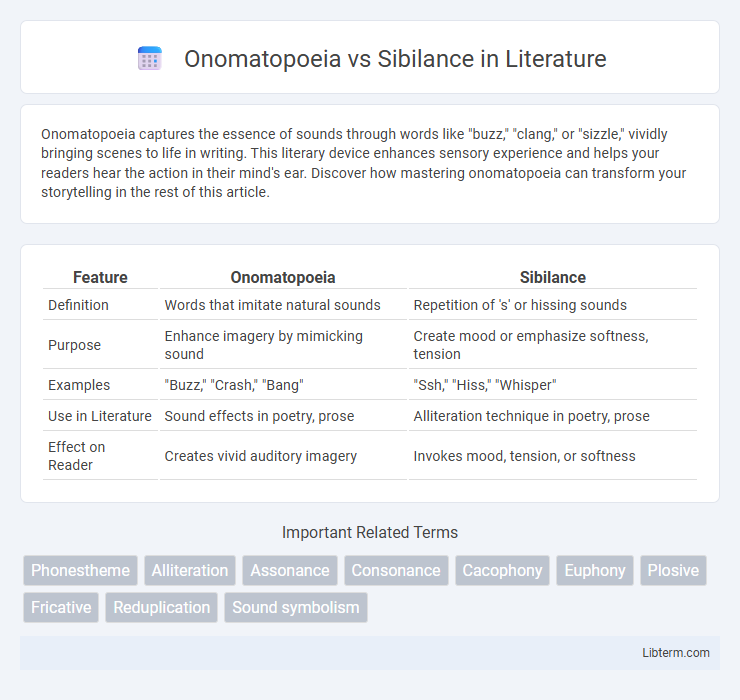Onomatopoeia captures the essence of sounds through words like "buzz," "clang," or "sizzle," vividly bringing scenes to life in writing. This literary device enhances sensory experience and helps your readers hear the action in their mind's ear. Discover how mastering onomatopoeia can transform your storytelling in the rest of this article.
Table of Comparison
| Feature | Onomatopoeia | Sibilance |
|---|---|---|
| Definition | Words that imitate natural sounds | Repetition of 's' or hissing sounds |
| Purpose | Enhance imagery by mimicking sound | Create mood or emphasize softness, tension |
| Examples | "Buzz," "Crash," "Bang" | "Ssh," "Hiss," "Whisper" |
| Use in Literature | Sound effects in poetry, prose | Alliteration technique in poetry, prose |
| Effect on Reader | Creates vivid auditory imagery | Invokes mood, tension, or softness |
Understanding Onomatopoeia: Definition and Examples
Onomatopoeia refers to words that phonetically imitate or resemble the sound they describe, such as "buzz," "clang," and "sizzle," enhancing sensory experience in language. This figure of speech is commonly used in poetry, literature, and everyday speech to create vivid, immersive imagery by mimicking natural sounds. Understanding the role of onomatopoeia helps distinguish it from sibilance, which involves the repetition of hissing sounds like "s" and "sh" to create a specific auditory effect without necessarily imitating a real-world noise.
What is Sibilance? Exploring the Basics
Sibilance is a literary device characterized by the repetition of hissing consonant sounds such as "s," "sh," or "z," creating a soft, whispering effect in poetry and prose. This phonetic technique enhances the sensory experience and emphasizes particular emotions or moods, often evoking feelings of secrecy, tension, or eeriness. Unlike onomatopoeia, which imitates natural sounds, sibilance focuses on the stylistic use of sound patterns to enrich the auditory quality of language.
Key Differences Between Onomatopoeia and Sibilance
Onomatopoeia refers to words that phonetically imitate the sound they describe, such as "buzz" or "crash," while sibilance specifically involves the repetition of hissing consonant sounds like "s," "sh," or "z." The key difference lies in onomatopoeia capturing actual sounds in word form, whereas sibilance is a stylistic device focused on producing a soft, hissing auditory effect. Onomatopoeia functions primarily as a representation of real-world sounds, whereas sibilance enhances rhythm, mood, and tone in poetry and prose.
How Onomatopoeia Enhances Writing Style
Onomatopoeia enhances writing style by creating vivid sensory experiences through words that imitate natural sounds, such as "buzz" or "crash," making descriptions more immersive and engaging for readers. Unlike sibilance, which emphasizes repeated hissing sounds through consonant repetition, onomatopoeia directly evokes the auditory essence of objects or actions, enriching the emotional impact and realism of the text. This technique strengthens imagery and rhythm, drawing readers deeper into the narrative by appealing to their auditory imagination.
The Role of Sibilance in Literature and Poetry
Sibilance creates a hissing sound through the repetition of 's,' 'sh,' and 'z' consonants, enhancing mood and tone in literature and poetry by evoking sensory responses such as tension or softness. This literary device intensifies emotional impact and imagery, often contributing to a poem's sonic texture or a narrative's atmosphere. Unlike onomatopoeia, which imitates natural sounds, sibilance manipulates phonetic patterns to influence readers' emotional engagement and rhythmic experience.
Comparing Sounds: Onomatopoeia vs. Sibilance in Text
Onomatopoeia mimics natural sounds directly, such as "buzz" or "clang," creating vivid sensory experiences in text. Sibilance emphasizes the repetition of soft "s" or "sh" sounds, enhancing mood and rhythm through subtle, hissing auditory effects. Comparing these, onomatopoeia provides explicit sound imagery while sibilance crafts atmosphere via phonetic repetition.
Common Onomatopoeic Words in Modern Language
Common onomatopoeic words in modern language, such as "buzz," "click," and "pop," mimic real-world sounds to enhance imagery and auditory appeal. Unlike sibilance, which emphasizes repeated 's' or hissing sounds to create rhythm and mood, onomatopoeia directly imitates noises, making descriptions vivid and immersive. These words play a significant role in literature, advertising, and everyday speech to convey sensory experiences effectively.
Famous Literary Uses of Sibilance
Sibilance, characterized by the repetition of soft consonant sounds like "s" and "sh," enhances the auditory imagery and mood in literature, famously employed by Edgar Allan Poe in "The Raven" to evoke a haunting atmosphere. Shakespeare's use of sibilance in "Macbeth," particularly in the witches' chants, intensifies the eerie and sinister tone, demonstrating its power in dramatic tension. Unlike onomatopoeia, which mimics natural sounds, sibilance subtly influences rhythm and tone, making it a favorite device in poetry and prose for atmospheric effect.
The Impact of Sound Devices on Reader Experience
Onomatopoeia creates vivid sensory experiences by mimicking natural sounds, engaging readers through auditory imagery that enhances immersion and emotional connection. Sibilance, characterized by repeated 's' or 'sh' sounds, introduces a soothing or hissing effect that can evoke tension, calmness, or sensuality depending on context. Both sound devices manipulate phonetic patterns to influence reader perception, pacing, and mood, ultimately enriching the textual atmosphere and emotional resonance.
Choosing the Right Device: Onomatopoeia or Sibilance for Your Writing
Selecting onomatopoeia enhances vivid sensory experiences by mimicking natural sounds such as "buzz" or "clang," making descriptions more immersive. Sibilance, characterized by repeated 's' or 'sh' sounds, intensifies mood through soft or hissing tones, often creating tension or serenity. Writers should evaluate their desired emotional impact and auditory effect to decide between onomatopoeia's direct sound imitation or sibilance's subtle auditory texture.
Onomatopoeia Infographic

 libterm.com
libterm.com